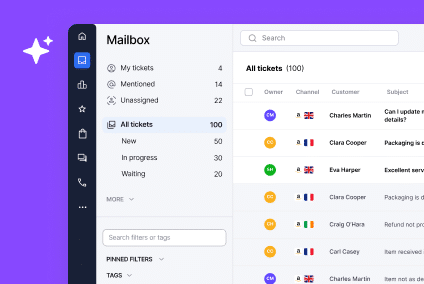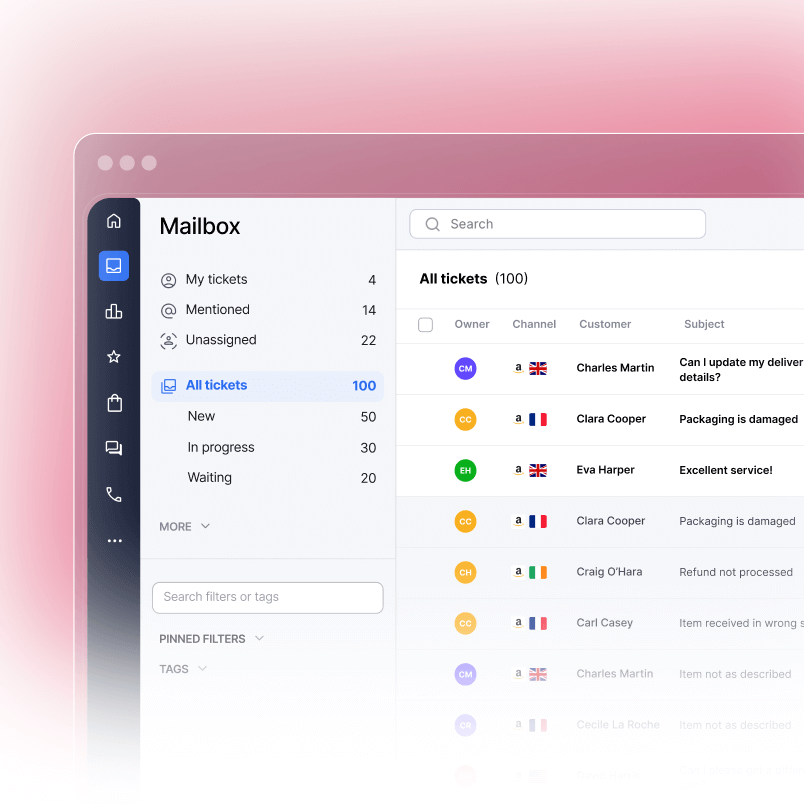If you’re selling on Amazon, the Amazon Message Center is your primary support hub …it’s where bewildered shoppers, anxious newcomers, and excited Amazon reviewers come together to discuss everything from tracking inquiries to glowing five-star reviews.
However – word to the wise – many sellers allow this important channel to become a bit of disorganized mess of an inbox, and Amazon customers are quick to judge when responses are delayed.
So don’t let this be you! Here’s how you can avoid it:
We’re going to cover…
- The importance of quick and friendly messaging for Amazon’s algorithm
- Ways to automate repetitive tasks in Amazon Seller Central and eDesk
- Response templates that can be easily copied and pasted while ensuring full compliance with policies
- Helpful tips for mobile support with the Amazon Seller App
- When to reach out to Amazon Seller Support phone numbers or the Amazon Seller Forums
- A practical workflow that integrates smoothly with your current Amazon Storefront operations
1. Understanding the Amazon Message Center
The Amazon Message Center, also known as “Buyer‑Seller Messaging,” can be found in Amazon Seller Central and the Amazon Seller App. Customers can get in touch with you from their order page or purchase history, and you can respond through Seller Central, using email relay, or via an approved help-desk tool, such as eDesk.
Why Does it Matter?
- Happy customers lead to higher bestseller rankings
Sellers on Amazon benefit from keeping up with replies and maintaining a response rate of over 97%. Delayed responses can negatively impact your seller metrics on Amazon Seller Central and may even lead to account suspension. Not ideal, we think you’ll agree. - Adhering to policies
Amazon monitors every message you send. Be warned.. promotions, external links, emojis, and requests for positive feedback can all breach policy and lead to restricted messaging if you’re not careful. - Brand reputation
When evaluating your credibility, shoppers often look back at previous conversations. Well-crafted, professional messages turn casual visitors into customers. Don’t treat your customers like friends, treat them like customers.
2. Prepare for Success: Email Organization
a. Enable Message Categories
Go to Seller Central, then navigate to Settings and select Notification Preferences. From there, enable the “Buyer Messages” option. This helps your dashboard highlight messages by order ID, making it simpler to follow threads.
b. Create Labels or Tags
If you use eDesk, set up tags like “Returns,” “Shipping Delay,” “Product Inquiry,” and “Prime Day Surge.” Using color-coding clearly highlights what should be prioritized.
c. Define SLAs
Amazon expects customers to receive initial responses within a 24-hour timeframe, including weekends and holidays. You have an opportunity to both please and impress them with a response time of under 6 hours during business hours, and under 12 hours outside of those hours. The analytics dashboard from eDesk automatically keeps track of this.
3. Automate the Repetitive, Personalize the Critical
a. Rule-Based Auto-Responses
| Trigger | Example Rule | Outcome |
| Request for order status | If the message includes “where is my order” and tracking information is available | Automatic response featuring a live tracking link |
| Weekend messages | If a message is received between Friday at 8:00 PM and Monday at 8:00 AM | Send friendly acknowledgement + SLA |
Here’s how you can set this up:
- For Seller Central users, navigate to Settings and then select Messaging Automation. Unfortunately, though, it’s worth noting that this has limited functionality.
b. AI-Suggested Replies
eDesk’s AI assistant reviews incoming messages, understands the intent, and offers suggested responses that you can approve with a single click. This saves you minutes per ticket, and during the hectic Cyber Monday rush, every minute counts. (In fact, let’s be honest, this is your precious time – every minute counts all year round.)
4. Best-Practice Templates (Copy, Paste, Adjust)
Feel free to use the suggestions below as a foundation – just incorporate your brand’s unique voice and any specific details you need. All of these are Amazon policy-compliant (no marketing fluff, no external links, no review manipulation), so you can be confident you won’t be breaching any policies.
| Scenario | Template |
| Shipping Update | Hi {CustomerName}}, thanks for reaching out. Your order {{OrderID}} shipped on {{ShipDate}} via {{Carrier}}. Track it here: {{TrackingLink}}. Expected delivery: {{DeliveryDate}}. Please let me know if there’s anything else I can do to help. |
| Return Request | I’m sorry to hear the item didn’t work out. To start a return, please visit “Your Orders” and select “Return or Replace.” A prepaid label will be generated automatically. Once the item arrives, your refund will process within 2–3 business days. |
| Damaged Item | Apologies for the condition in which your {{ProductName}} arrived. We can ship a free replacement or issue a full refund; let me know which suits you best. Please keep the damaged unit until you receive return instructions. |
| Positive Feedback Acknowledgement | Thank you so much for taking the time to share your experience! I’m thrilled the {ProductName}} is working well for you. If any other questions pop up, I’m just a message away. |
5. Hit and Beat Response-Time Goals
- Set aside an hour each day for the Message Center to really focus and power through.
It might help to group similar queries together and tackle them all at once, without switching your focus. - Utilize the Amazon Seller App on the go.
Turn on push notifications just for “Buyer Messages” to avoid distractions from algorithm alerts. - Take advantage of eDesk’s Smart Inbox.
It automatically groups and prioritizes all incoming tickets, so your team never has to do that extra legwork. No setup. No tags. No filters. - Make sure you escalate smartly.
If you need more advanced assistance, reach out to the Amazon Seller Support phone number, which you can find in Seller Central under Help and then Get Support. It’s a good idea to record the call in the ticket so the customer knows you’re on the case.
6. Staying Out of Trouble: Compliance Checklist
| Forbidden | Safer Alternative |
| A direct request for a 5-star review | “Your feedback helps us improve.” |
| External URLs (including your website) | Use only Amazon.co.uk or Amazon.com links |
| Emojis or GIFs | Plain text |
| Marketing/Promotional language (“Buy now & save!”) | Neutral, factual language |
| Sharing personal contact information | Keep communication within Message Center |
Make sure you conduct an audit every quarter. How? – Gather a sample of 50 responses, and if any violate policy, update the templates and retrain the agents. It’s as easy as that.
7. Beyond the Message Center: Community and Support
Check out the Amazon Seller Forums
Have a challenging customer request or a question about a policy that seems unclear? It happens to us all, don’t worry. And we can prove it… just search the Amazon Seller Forums and you’ll see evidence aplenty. Experienced sellers frequently share scripts or alternative strategies that come to the rescue. They’re a useful bunch and generally want one another to succeed, so it’s worth a look.
Keep Seller Support on Speed Dial
There are times when only Amazon has the power to make things right …like dealing with fraudulent A-to-Z claims or account suspensions. When you call the Amazon seller support phone number, having a clear summary and your case ID ready can help resolve issues faster. Which is in everyone’s best interest.
Troubleshooting FAQs
Q: I’m experiencing limitations on my message quota. Now what?
A: Amazon limits performance if you violate their policies or have a poor response time rating. Adjust the templates, respond more quickly, and it’s worth knowing that the cap typically raises after a week, so you can get back to normal pretty quickly.
Q: Am I allowed to add attachments?
A: Yes, but only for file types permitted by Amazon (PDF, JPEG, PNG) and only if they are necessary (like an instruction manual).
Q: What’s the best way to monitor which agent provided each response?
A: Amazon tracks the seller account exclusively, which isn’t that helpful for this. eDesk, though, keeps a record of individual agent IDs, so you get both accountability and valuable training data.
Key Takeaways
- Winning is all about speed. Try to respond within 6 hours.
- Streamline everyday tasks so that people can concentrate on more intricate challenges.
- Guarantee compliance by avoiding emojis, marketing tactics, and external links.
- Assess and refine. By which we mean using dashboards to identify slow days and template mistakes.
- Give your team the tools they need by establishing clear escalation channels, whether it’s through Seller Forums, Seller Support, or internal specialists.
Ready to Handle Amazon Messages Like a Pro?
Handling buyer communications on Amazon can be straightforward and manageable. eDesk allows you to simplify your support process by automating standard responses – this will speed up your replies, and give you a consistently outstanding experience for your customers. …Which means they’re much more likely to come back.
Whether you’re managing a high volume of orders daily or expanding your Amazon store into new territories, eDesk can make sure you remain compliant with Amazon’s guidelines, boost your seller ratings, and create customer loyalty …all from a single, user-friendly dashboard.




